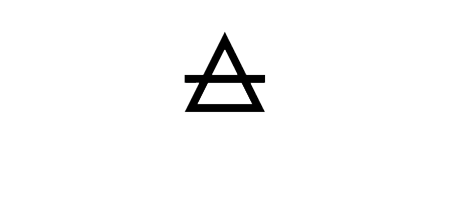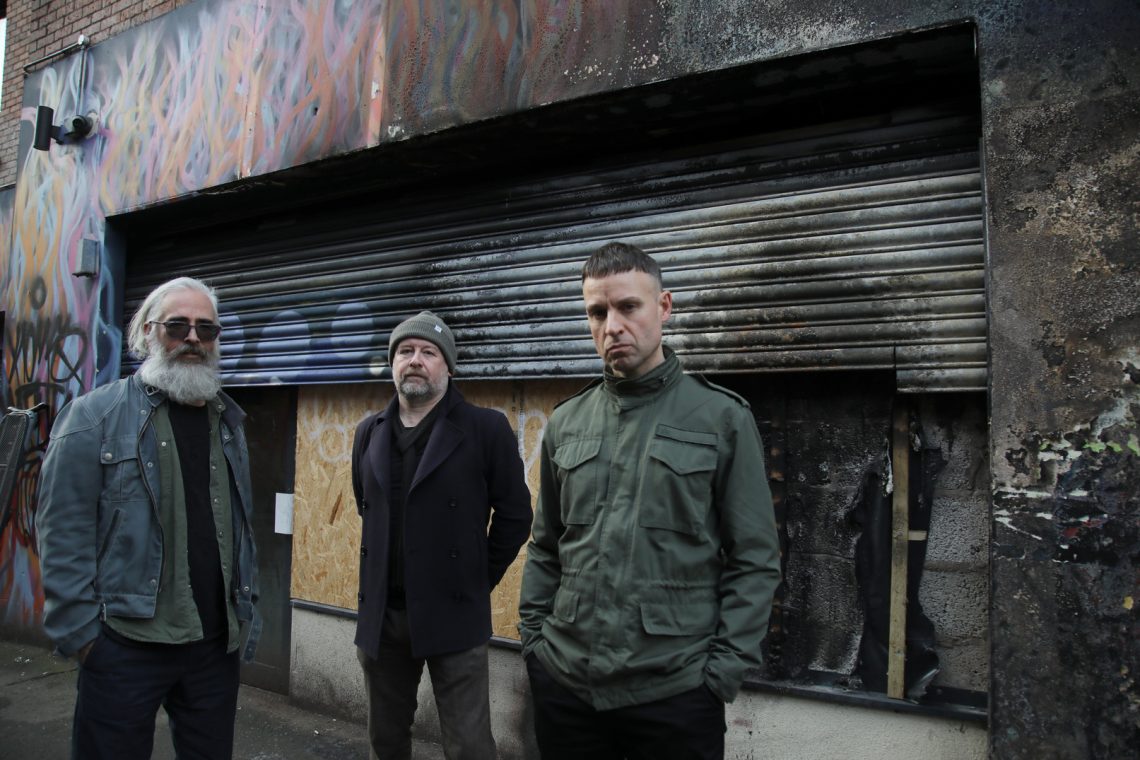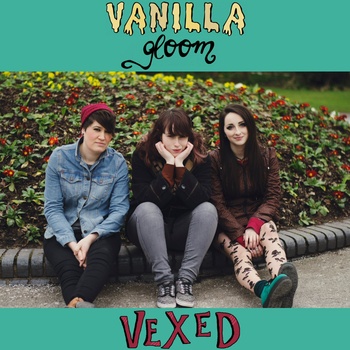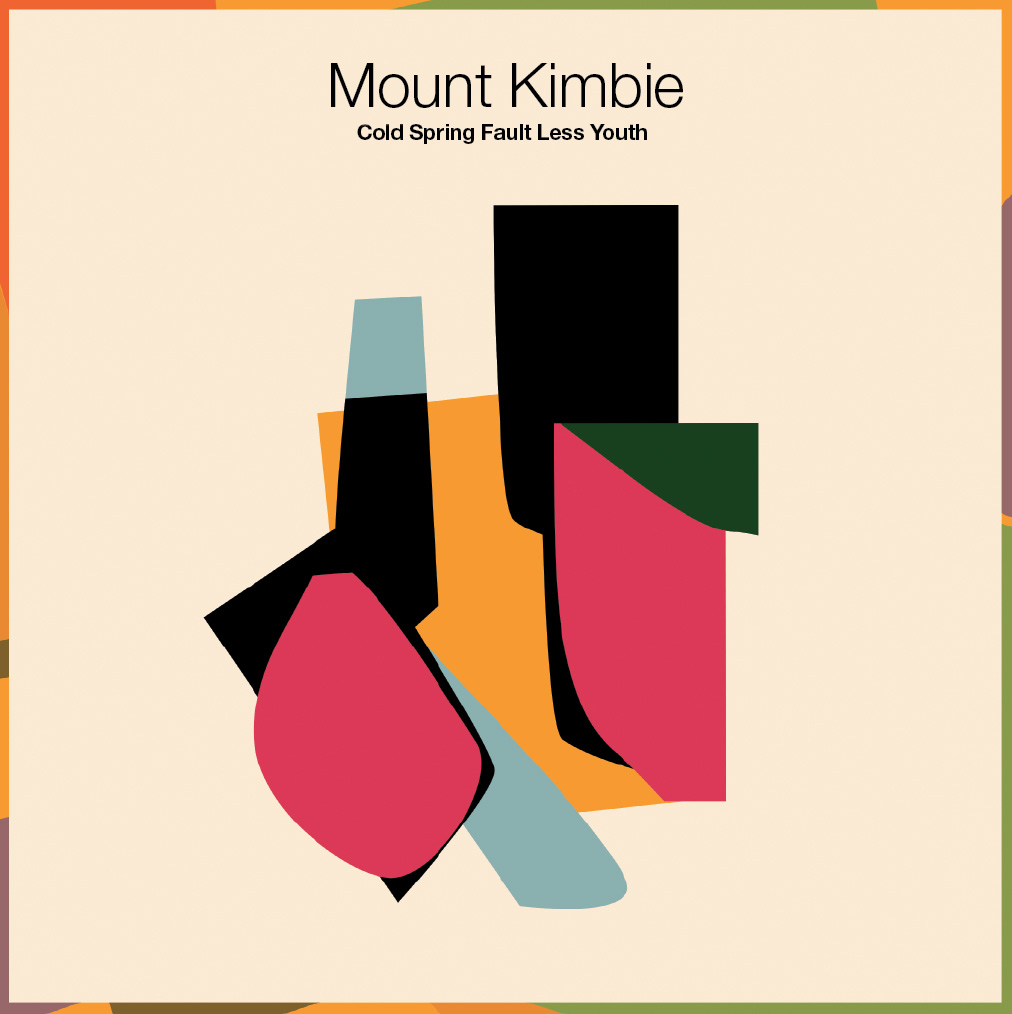Belfast’s Deeply Armed have been making subterranean waves for a while now. Tracks passed hand to hand via samizdat channels. Whispers between heads. Andrew Weatherall was an early booster. David Holmes played out a psychedelic version of one track at select ritual-like occasions. But now the trio break cover with ‘The Healing,’ a debut 12” that feels like a signal flare from a long-dormant dream.
The release comes bolstered by remixes from Andrew Innes (Primal Scream) and Brendan Lynch (Paul Weller/Lynch Mob) and Keith Tenniswood (2 Lone Swordsmen/Radioactive Man), a trio of producers who know a thing or two about locking into groove and blowing it wide open. Between them, they unearth new dimensions in a track that already fuses deep soul, krautrock propulsion and a quietly audacious sense of analogue pop craft. The result is something that reconciles the version, the loop and the live jam with the hallucinatory poise of a phantom mega-mix.
Deeply Armed call Belfast home but their sound drifts far beyond. Equal parts Neu! repetition, Northern Soul devotion and the cosmic dub of Sonic Boom and Conny Plank, their music speaks in pulses, phases and groove. It’s a sound they’ve cultivated over years of quiet collaboration, soldered together from dusty machines, reel-to-reel echoes and the kind of shared memory that only comes from long friendship and deeper listening.
Ahead of supporting Mad Professor and more, Brian Coney catches up with frontman Michael McKeown about the roots, rituals and revelations of Deeply Armed.
Hello Michael. I could be way off here but the three of you have clearly known each other for some time. What series of happenstances and shared musical obsessions brought you together and at what point did Deeply Armed become inevitable?
I started a club night over 20 years ago at the Front Page Bar on Donegall Street. It’s a gay club now but it was a proper old-school boozer back then. Journalists used to meet their sources there. At the weekends, there were some great underground club nights.
Our club brought a lot of like-minded souls together and that’s where I used to bump into Kenny and Aaron. I’d known Kenny on and off for years. Aaron was in a band and I invited them to play at one of the nights. He also painted himself blue for the gig and dressed like he’d time-travelled from the European Renaissance, which impressed me.
The underground electronic music scene in Belfast had raw energy back then, long before social media was a thing. It was very gritty, and there were some amazing parties. The Cathedral Quarter was an edgy place – it was difficult to entice people over to that part of town for a night out. I remember Asian Dub Foundation played for us once. They were DJing and MCing relentless Jungle to 300 people in a sweaty upstairs room. There was a bomb scare outside, and the British Army cordoned the entire street off. Nobody cared, they were too busy having a good time.
I had been DJing regularly for 15 years but I needed a breather from that world. I got chatting with Kenny about making some original music and we developed some demos with a drum machine, a sequencer, a bass and two guitars. I sent the tracks to Aaron, and he added some wobbly tape echo. From that point, we knew we were onto something.
Deeply Armed is tidily described as “analogue garage band smarts with a blissed-out Balearic feel,” evoking Neu!, Northern Soul loops and main man Sonic Boom. How did this cross-pollination come to reality – was it a conscious pursuit or did it naturally emerge from years of shared space and sound?
There was no conscious blueprint and no desire to release music, play live or seek attention. We were doing it for pure enjoyment. We all bring something positive to the table in terms of our musical influences, which come from all angles. From the outset, we liked the idea of using vintage instruments to make dance music and using machines to make rock n roll. The starting point is usually a beat and a bassline. Once we have a groove we experiment with percussive elements and live analogue effects. We develop a demo, remix the demo and then remix the remix. It takes the music on a journey, and we just ride the comet.
We hate labels but I suppose the Deeply Armed sound exists somewhere at the intersection between dub, techno and krautrock. Post-rave psychedelic kraut-pop in dub. How’s that?
David Keenan mentions tracks being passed around via “samizdat channels” and serious heads being in the know long before this single dropped. How did this low-key circulation happen, and what drew the right people in before you’d even officially ‘broken cover’?
We initially met every Saturday morning in Aaron’s home studio. We drank tea and tinkered for five or six hours, once a week. We stuck with it and kept going. We knew it was quality, but we weren’t interested in sharing the tunes with other people. We just enjoyed creating.
We did almost everything ourselves – writing, playing, producing and mixing it all by ear. Aaron engineered it, and we brought some contributors in here and there. Our privacy was important, so we put some confidentiality agreements in place.
I guess the turning point came when we finished recording the album. We wanted to get the songs mastered but we’d been so close to it that we felt it needed fresh ears. Keith Tenniswood has been a friend for years and I trust him implicitly, so I sent it him to see if he would do the mastering.
Keith is so passionate about music – and sharing music -and he was really excited by what he heard, which was nice to hear. He kept telling me that it needed to be heard. I also sounded out Richard Fearless and Andrew Weatherall who I also trusted. Remixes were discussed, and our mindsets started to change.
The recording approach for your debut debut single ‘The Healing’ was fully analog and deeply organic, with the backing vocals of two sisters from Donegal, Sinead and Mairead Smyth, captured live with a solid single instruction: “sing with feeling.” Can you tell us more about that session and what it is about live, analogue recording that continues to capture something modern methods can’t?
Recording that song was an organic process and very natural. We tried to keep everything in the mix, including the imperfections. We like to capture the beauty of the moment. It was essentially a studio jam – Kenny laid down the bass, Aaron played a vintage Clipper analogue synthesizer, and I played the acoustic guitar in one long take. Saul’s drums and Mairead and Sinead’s backing vocals took it into another dimension. At the time, the words were just guide lyrics, but we loved the idea of a hypnotic psychedelic hymn so we left them alone.
Mairead and Sinead are sisters, and I think that sibling dynamic shines through in this song. If you think about The Jacksons, The Clancy Brothers, The Andrews Sisters, The Beach Boys – that genetic connection adds another dimension if it’s done right.
I’d mentioned before that The Everly Brothers used to sing into one microphone, and we loved that idea, so we asked them to harmonize – in one extended take – into a single vintage mic. They’re from the Inishowen Peninsula in Donegal, and we felt they added a sense of Irishness. We liked the idea of channeling that indigenous tradition of rural fireside singalongs, passed through centuries.
The track itself insists that Deeply Armed – and music itself – brings the healing. Is that sentiment something that runs deeper than just the song title? What does music heal for you?
In any situation where there is suffering or pain, I think we, as human beings, naturally grasp around for something to try to soften that pain. I think music has mystical properties in this respect. We all have individual frequencies, but I think that music can act as connective tissue between shared human experiences. It might not take the pain away, but it can help, whether that’s writing, performing or listening. It can soothe the soul in the toughest times.
The song’s Motorik pulse gets disrupted by drummer Saul Rayson’s military-style breakdowns, adding a heady, physical dimension. Is the main role rhythm in your music about propulsion, hypnosis or something else entirely?
Rhythm is sacred ground for us. When Saul drummed on The Healing, we were aiming for a slow, propulsive beat as the backbone of the song. For the breakdown, we experimented with a militaristic drum solo to try and disrupt it. It shouldn’t really work in this context, but he’s an amazing drummer so we knew he would nail it. More generally, we love repetitive beats and creating a hybrid of live drumming and drum loops is interesting territory to explore.
I do believe there’s an intrinsic link between rhythm, its effect on our brain chemistry, emotional processing and physiological response. We hear our mother’s heart beating in the womb, before we’ve entered the world. The Nyabinghi tribe are the strictest sect of Rastafarianism. Their drumming replicates the sound of the human heartbeat which for them represents the providence of Jah. If you think about the role of the Bodhrán in Irish traditional music, the 909 kick in techno and, obviously, the main man Klaus Dinger’s motorik beat.
Lee Perry once said that “the bass is the brain, and the heart is a drum.” That’ll do for us.
There’s a pure-cut magic that comes from artists who have been steeped in their influences long enough to process them into something wholly their own. Many “younger” bands draw from similar wells but fail to follow through. Do you think arriving at this moment with years of deep listening behind you has been essential?
Absolutely. If we had made this record 20 years ago, it wouldn’t sound the same.
For me, personally, DJing regularly for so long meant I was immersed in sound. Warming up for people like Weatherall was an education. I get bored easily, and I always like to push myself out of my comfort zone. I’ve always found that sharing music with people in clubs and after clubs broadens your knowledge base, and that plays an important role when I’m making music.
Aaron has stockpiled loads of vintage synths and effects units and he’s been tinkering in the studio for years, without releasing anything. Some of his work is mind blowing but it’s as normal to him as making a cup of tea. Kenny is always going to quality live shows and that flows through when he plays his Fender Precision. We still love listening to music together and discussing what we love and hate. I think Deeply Armed is a natural extension of this.
Between samizdat whispers, Weatherall’s early blessing and the smoke-ring echoes of a scene that moves in the shadows, Deeply Armed already feels like a project that exists in both the seen and the unseen. How much of your process is about actively embracing that phantom presence – tapping into the hidden frequencies of music, culture and memory?
I think that’s a fair synopsis. In a studio context, that “phantom presence” has always been a thing for us. I remember reading an interview with Dylan and he said he didn’t know how he came up with his songs and that they were magically written. He obviously stands alone as an artist but we can relate to the general point – that notion of the muse, streams of consciousness, channeling. For any artist, I think subconscious fragments of culture and memory crystallize within that creative process. Once you’re in that space, it’s very immersive.
Our album was finished five years ago and listening back now, we’re not sure how we made those songs. We don’t spend too much time thinking about it. The main thing for us is creating stuff and having fun.
Artists tend to overexpose themselves these days. Social media has its place but some of the self-promotion is beyond embarrassing. That world doesn’t interest us. We prefer to channel the spirit of acid house – clandestine, uplifting and accessible to the right kind of people.
As you will know more than most, Belfast’s very best exports are as script-flipping as they come. To what extent do you think you three feel connected to that lineage of rebels and upsetters?
In Belfast, the conflict has left deep psychological scars, but people in this part of the world are storytellers who like to enjoy themselves. Those are interesting dynamics, and art obviously provides a conduit for self-expression. If it’s a rebellious message and it’s from the heart, then long may that tradition continue.
Belfast is our home, it’s where we made our album, but to be honest, we made a conscious decision not to try and plug in to any kind of local music ‘scene’. Going down that route can get a bit insular and parochial, which doesn’t appeal to us. If people are into it, wherever they’re based, then they’re very welcome to climb aboard.
Brendan Lynch and Primal Scream’s Andrew Innes’ ‘Born to Go’ brings a trash-glam aesthetic that filters Primal Scream’s XTRMNTR chaos, sealed with Dee Dee Innes’ psychedelic doo-wop vocals. How did this remix come about and what was it like hearing your song reimagined through their lens?
Kenny and I are big fans of XTRMNTR, Vanishing Point and Evil Heat. For me, those albums are the pinnacle of the Primal Scream canon. I remember hearing ‘Accelerator’ for the first time, and it sounded so intense. The way it was mixed – I couldn’t work out whether there was something wrong with my ears or my speakers.
I was introduced to Innes through Mani, years ago at Scream gigs and I’ve bumped into him a few times since. I remember DJing at an illegal after-party for them in Belfast. I’m pretty sure Innes and Throb were still rocking leather trousers at that point. That was long before we started making music. It’s funny how the circle has turned years later.
Keith Tenniswood and I were chatting about who might be a good fit to remix the music and Innes’s name came up. He doesn’t really do many remixes, to the best of my knowledge, but he loved the tune and said he thought it sounded like Cluster, which delighted us.
He had some downtime during COVID and offered to work on it. We don’t get involved when people are remixing our music, so we told him to do whatever he wanted. Brendan Lynch was also up for it, so they disappeared to Brendan’s studio and smashed it to bits. It’s the first time that Dee Dee has sang on a record, so it was a proud moment for Andrew.
When the remix landed in our inbox, it blew us away. They really enjoyed making it, and I think that shows. For me, it sounds like a long-lost XTRMINTR track and a potential cult classic. Garage rock, punk, glam and do-wop packed into a relentless two-minute onslaught. Amazing.
A second remix sees Keith Tenniswood flip the song into some hybrid of lovers’ rock, trance and glockenspiel-hypnotic Kraut euphoria. Did this version reveal something new about the song that you hadn’t necessarily heard in it before?
It’s funny – every producer who worked on a remix for us seemed really invested in the songs. They were all doing it for the love and it really seemed to click. This one from Keith really blew us away. We couldn’t believe the synchronicity between what we were feeling in the studio and what he’d created for us I always loved ‘Autobahn 66’ – the Primal Scream tune produced by Weatherall and Tenniswood as 2 Lone Swordsmen. Creating a fresh take on Krautrock using drum machines is no mean feat Although Andrew has sadly left this world, Keith channels the 2LS sensibilities with his remix of The Healing.
It’s difficult to describe – he has somehow extracted the soul of the original song and taken it into another dimension. The xylophone, the strings – it’s so expansive and absorbing. He put his own name to it rather than his Radioactive Man moniker which is special. David Keenan described it as “lovers trance” and “the kind of groove you wanna live inside forever.” Amen to that.
Without entertaining complete reductionism, there’s something inherently ritualistic in the way The Healing unfolds – repetitions that don’t circle so much as subtle ascend. It’s early days but do you see the project as operating in that liminal space between composition and séance, where your particular groove becomes the message?
Groove is a thread that runs through all of it, for sure. At the end of the day, we can get bogged down over analysing it, but we want people to dance, sway or nod their head, so you need a groove to make that happen.
‘The Healing,’ for example has a long intro, a drum solo and only features five words sung by three people. It’s maybe an unorthodox choice for a debut single. We all felt, though, listening back, that there was something spiritual about it, like a séance, as you say. I think it works whether you’re sitting in the dark, looking at the sun or having a boogie.
As for the other tunes we’ve written, there was no grand plan. There are nine songs on the album. Some are relatively short while others are extended jams. There is a nice balance, and people will get their money’s worth.
With upcoming shows in Belfast and Glasgow – including support for Mad Professor – are these your first live performances as Deeply Armed? What’s the feeling going into them?
Taking the music into a live context has been a separate undertaking. We’ve spent the last year and a half figuring out the best way to do it. In the studio, we all play different instruments and contribute to the overall sound. No one has strictly defined roles and we enjoy that freedom. When we discussed how a live band might work, we knew we had to take a different approach. We had to streamline our roles as we hated the idea of swapping instruments on stage, which can seem a bit self-indulgent. That’s been an interesting process – unlearning the tunes and piecing them together within a live performance. Saul is also drumming live throughout the set which breathes a different kind of energy into the songs.
We did a private show in December, and we played God’s Waiting Room for David Holmes last month. People were grooving and the feedback was great. We’ve worked with Mad Professor on some remixes of our next single. We’re massive dub fans, so we’re looking forward to that show in May. We’ll then play Glasgow for Manifesto of Bliss – those guys are kindred spirits and they’ve been very supportive. We’re aiming to go over there and blow the roof off.
With the single out, the secret’s out. What’s next?
The single is making waves, all things considered. Record shops in London, Tokyo, Hamburg and Milan are selling it. Piccadilly Records in Manchester have called it as their single of the year so far, which is great as we all love that shop and rate the people who run it.
We haven’t announced it yet, but Richard Fearless from Death in Vegas has also remixed The Healing and we’ve pressed it as a limited-edition white label. It’ll be on sale soon.
Mad Professor and Andrew Fearn from Sleaford Mods have done remixes of the next single, which will be out soon. After that, we’ll release the album, followed by the final single which has been remixed by David Holmes and Keith Tenniswood. David’s remix has been popping up within his DJ sets recently, and the reaction has been pretty euphoric.
Aside from all that, we’ll make more connections, play more gigs and continue working on the next album, which is already shaping up.
Catch Deeply Armed support Mad Professor at the Black Box in Belfast on 24th May. Tickets here







